Learn how easy it is to make homemade chocolate with only 3 essential ingredients needed: cocoa butter, cocoa powder and a sweetener of your choice. You can easily make this chocolate vegan, low carb and paleo friendly by choosing the right sweetener for you!
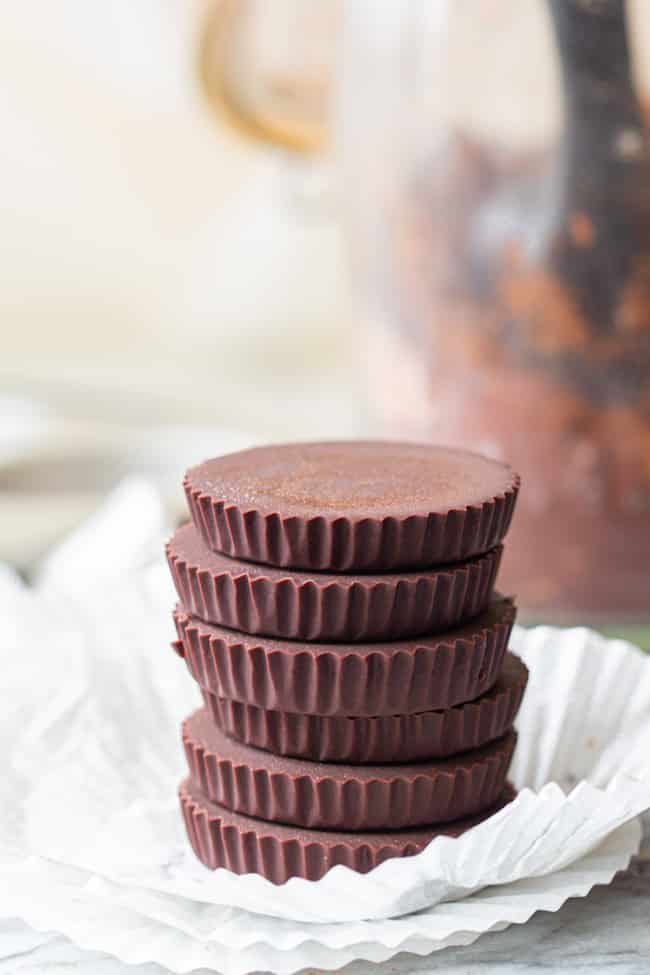
What is cocoa butter?
Cocoa butter is the edible fat extracted from, you guess it: cacao beans. It’s got a naturally chocolatey smell and taste making it a perfect addition to homemade chocolate. Despite the name, cocoa butter is naturally dairy free/vegan so don’t worry about the ‘butter’ in the name.
It’s typically sold in solid, block-like form that you’ll need to chop up to melt. I recommend using a kitchen scale to measure out what you need otherwise it might be too tedious to melt and then measure.
Cocoa butter can be hard to find and very expensive which is why I don’t often use it in recipes. Since I got so many questions about how to make homemade dark chocolate in my other chocolate recipe I thought I’d take the time to dedicate a separate recipe here explaining exactly how to use it.
So let’s get to it!
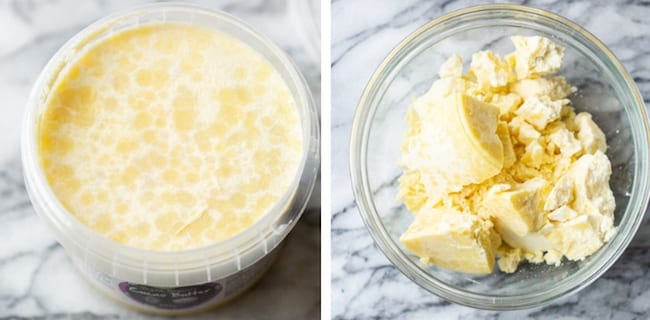
Cocoa Vs Cacao
Cocoa and cacao are so similar in name, look and product that they can so easily be mixed up. That being said there are a few key differences to know that will help keep it all straight:
| CACAO | COCOA |
| cacao refers to the name of the plant/seeds and the minimally processed products that are derived from it | cocoa refers to all of the products that come from cacao plants that have been processed in high temps |
| cold pressed & heated in low temperatures – raw | roasted & cooked in higher temperatures – not raw |
| less processed – more bitter | more processed – more sweet |
| high antioxidants & nutritional value | less antioxidants & nutritional value |
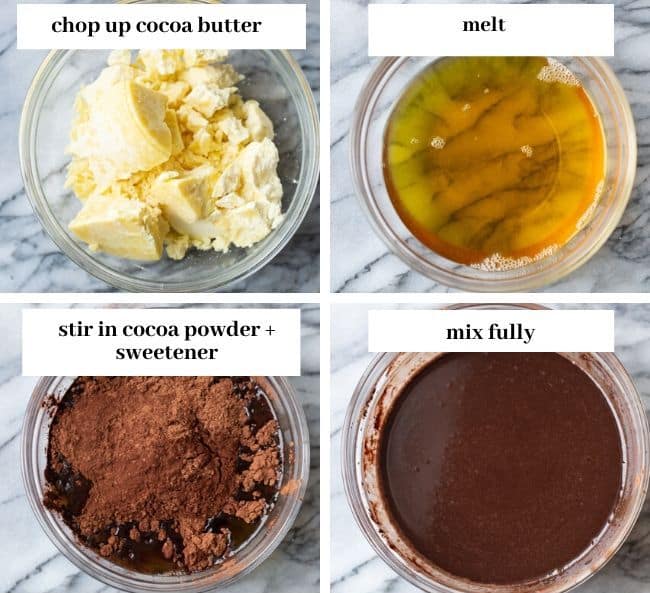
What should I use here?
Whatever you have! Cacao powder/butter, cocoa butter/powder, unprocessed cocoa powder, dutch processed cocoa powder, etc.
The type of cocoa/cacao that you use in this recipe really only depends on you and your preference. Use cacao products if you’d like to make raw chocolate with a few extra health benefits. Use cocoa/dutch processed chocolate if you like your chocolate a little sweeter. They’ll all work here so don’t sweat it.
What type of sweetener can I use to make homemade chocolate?
It’s up to you! You can use more natural sweeteners like maple or honey, low carb/keto sweeteners like stevia or erythritol or even plain white caster sugar or powdered icing sugar if you prefer.
If you choose to use a coarser grain sugar like caster sugar, you will need to mix and warm the mixture longer to ensure the grains fully dissolve.
Updated Note on Sweeteners:
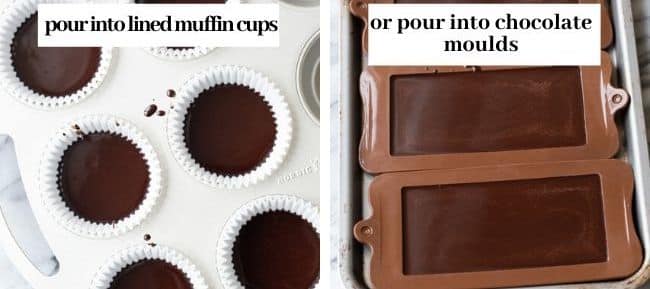
A couple things that you’ll need to keep in mind:
- You’ll need more or less sweeteners depending on the type you use.
- Honey and maple are sweeter to taste than plain white sugar and erythritol so you need less honey/maple than you would the sugar/erythritol.
- Liquid stevia is naturally very sweet – you’ll need to measure it out in drops and not cups.
- Start out with a small amount of sweetener and taste and as as you go. You can always add more sweetener but you can’t take it away.
- Make sure you fully dissolve whatever sweetener you use – especially if you’re using a granulated sweetener.
What percentage dark chocolate is this?
This is going to depend on how much and what kind of sweetener you use to make your chocolate.
Chocolate percentage refers to how much cocoa/cacao products are in your chocolate. As a really base explanation, it’s a measure of how much sugar is in a bar of chocolate.
This recipe is made up of essentially three ingredients:
- 1 cup | 220 g cocoa butter
- 1 cup | 118 g cocoa powder
- 1/4 cup | 79 g maple syrup (for this example I’m just going to use 1/4 cup maple, but this amount/type of sweetener can be changed to suit you)
The Math
If you add up all of those amounts together you’ll end up with a chocolate that weighs 417 grams. The cocoa butter and cocoa powder together in this recipe weigh 338g. In order to calculate the percentage you need to divide 338g by 417g and you’ll end up with .8105 g . Once you move the decimal point over two places as you should when calculating percentages you’ll end up with 81.05%. SO if you’re only using 1/4 cup maple syrup you’d end up with an 81% chocolate.
However, you need to keep in mind that different sweeteners weigh different amounts. 1/4 cup maple syrup weighs 79 grams but 1/4 cup honey weighs 85 grams and 1/4 cup white caster sugar weighs 50 grams. If you use something like stevia you’ll end up using much less which will also change the chocolate percentage. That’s just one reason why a 70% chocolate bar can taste so different depending on the brand.
To sum it all up the Math
It really just depends. If you use 1/4 – 1/2 cup maple or honey your chocolate will be some where between 65%-80%. If you use more or less sweetener, you can calculate the percentage yourself by adding up the weight and then dividing the weight of the cocoa products (338g) by the weight of the sweetener.
Hope you enjoy!
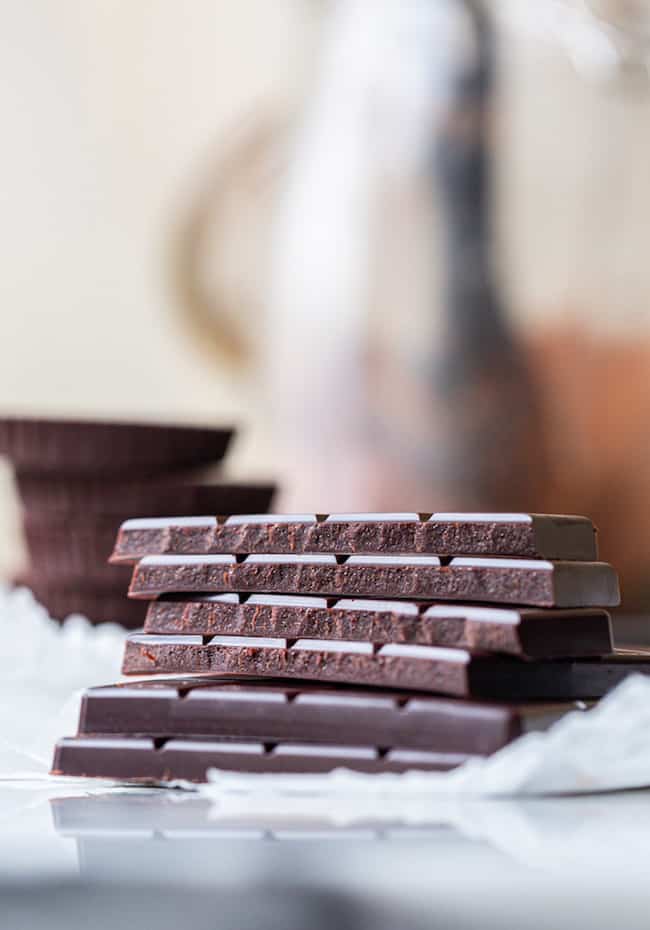

Homemade Chocolate with Cocoa Butter
Learn how easy it is to make homemade chocolate with only 3 essential ingredients needed: cocoa butter, cocoa powder and a sweetener of your choice. You can easily make this chocolate vegan, low carb and paleo friendly by choosing the right sweetener for you!
Ingredients
- 1 cup | 220 g cocoa butter
- 1 cup | 118 g unsweetened cocoa powder
- 1/4 - 1/2 cup | 80g - 160g maple syrup, honey, agave etc*
- Pinch of salt
Instructions
- Chop up and melt the cocoa butter. You can melt directly in a small sauce pan over a low heat or in the microwave. Once melted remove the cocoa butter from the heat. To make raw chocolate, melt the cocoa butter slowly over a water bath (see notes).
- When the cocoa butter has fully melted, stir in the cocoa powder, sweetener, sea salt and any additional flavours you want to add.
- Whisk everything completely until there are no remaining lumps of cocoa powder and the honey has dissolved into the chocolate mixture.
- Pour the chocolate into silicone moulds or a lined muffin cups and transfer to the fridge for at least 30 minutes. Once the chocolate has fully hardened, pop it out of the moulds and enjoy.
- Keep stored at room temperature or in the fridge.
Notes
- I no longer recommend adding vanilla extract (or other flavored extracts) to this chocolate as most extracts contain a small amount of water which can cause the chocolate to seize. If you would like to add flavors I recommend you use a food grade oil (like mint, orange, cherry, coffee, etc) instead.
- Optional: Melt over a water bath. Place the cocoa butter in a medium sized heat safe bowl. Place the bowl over a small pot of simmer water. Make sure the bottom of the bowl doesn't touch the water. Let sit and stir occasionally until fully melted.
- How much & what kind of sweetener to use: This recipe is meant to be a 'healthy/healthier' chocolate that uses natural or unrefined sweeteners. For this reason I recommend honey or maple syrup however you can try out different type of sweetener here like. Remember that all sweeteners are different - some sweeter than others. Play around with the amounts you use based on your preference. Honey produces the most consitent results due to its low water content. If you're not concerned about using natural sweeteners, then I recommend you use 3/4cup -1 cup icing/powdered sugar.
- If using a crystal based sweetener (rather than a liquid sweetener): Melt the cocoa butter on a very low heat and then add the sugar/sweetener. Keep on a low heat and stir constantly until the sugar dissolves. Then add the remaining ingredients.
- If it's important to you, keep in mind that honey is not vegan.
- This chocolate will melt if heated so it's not suited to use in baking.


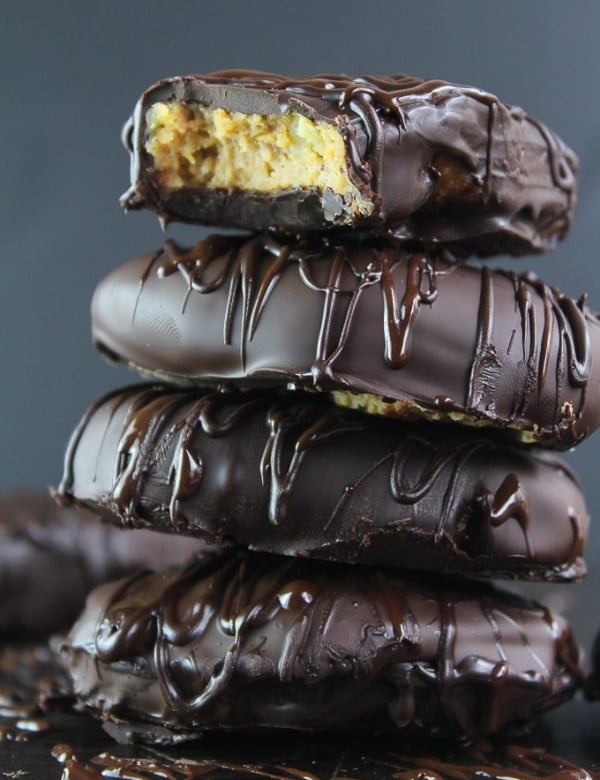
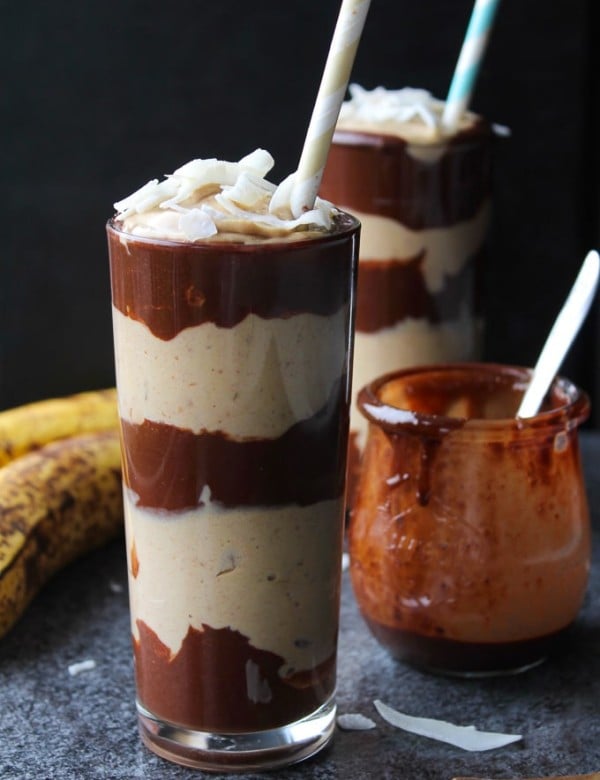
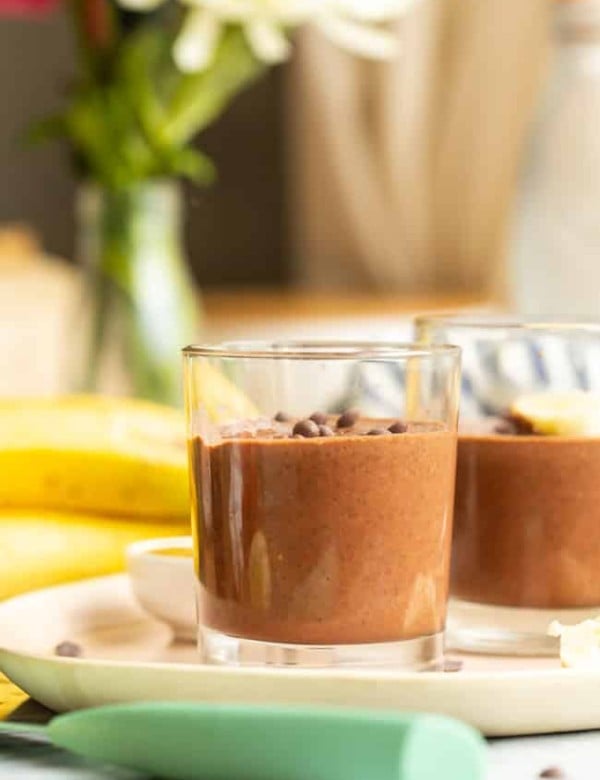
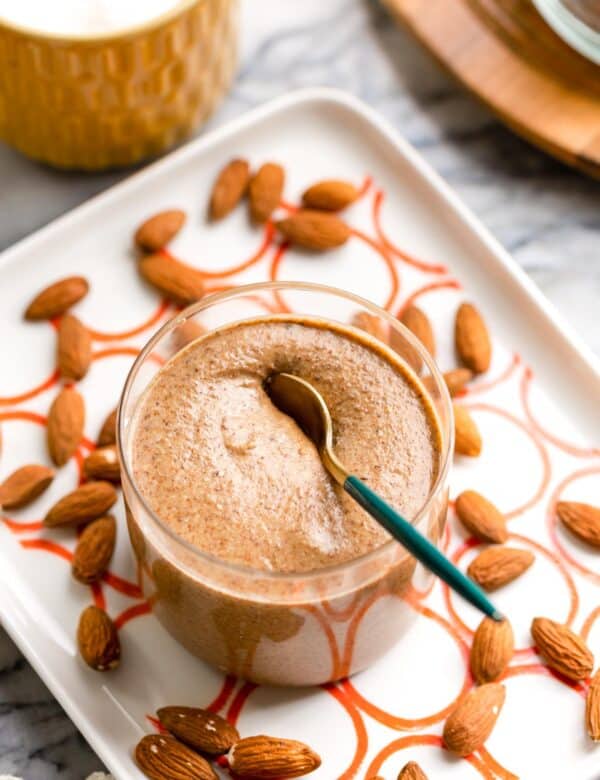
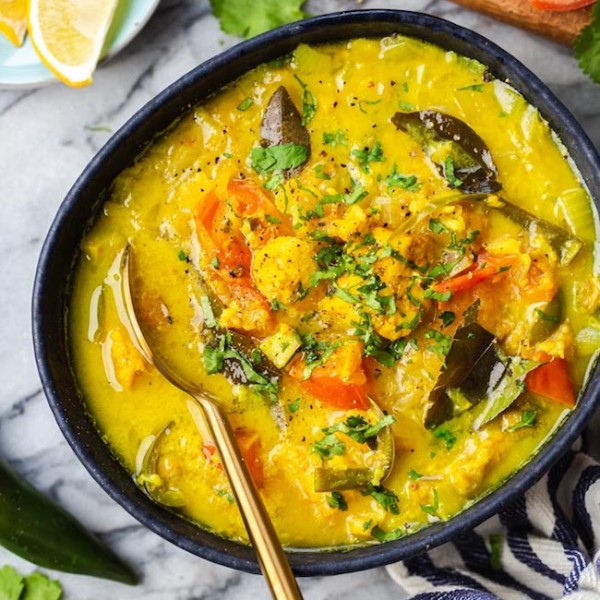
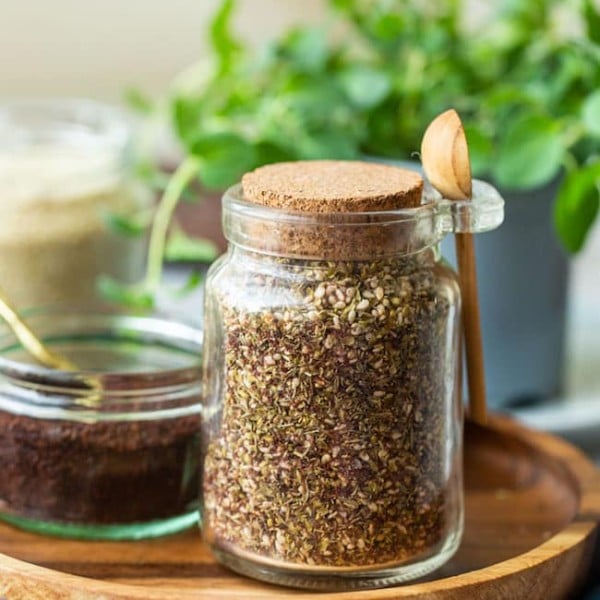
Jim says
The amount of cacao powder at 118g is a lot more than a cup.
Sarah Nevins says
Hi Jim! The tricky thing about weighing ingredients with measuring cups is the fact that the volume can vary wildly depending on a lot of different factors (how much an ingredient is packed, how much moisture it has etc). I like to double check my amounts with a few different places when I list the weight of an ingredient to double check. Based off of a quick google search I can see that there seems to be a lot of variation here with some places saying 1 cup equals about 80 grams and other places listing closer to 125 g.
Traditional oven is usually the most reliable in my experience and tends to be my main go to: https://www.traditionaloven.com/culinary-arts/baking/cocoa-powder/convert-us-measuring-cup-to-gram-g-of-cocoa-powder.html
sandra Kelson says
Thank you so much! I love to bake, baking and giving it away is my favorite thing to do. However my best friend is vegan and gluten-free, its so hard to find something delicious, beautiful and that fits that criteria. This chocolate did the trick! I added some nuts and V/GF toffee used an adorable mold and she was in heaven! Thank you so much
Sarah Nevins says
Hi Sandra! It makes me so happy to hear that you were able to make this for your friend! I also LOVE the toffee & nuts addition – it sounds delicious!
Anais says
Can I use also this chocolate for a Ganache or to melt it and cover a cake? I cannot find chocolate without sugar where I live so I’m thinking to do it myself.
Thank you very much.
Sarah Nevins says
Hi Anais! If you’re looking for something more along the lines of a ganache then I recommend you check out this recipe instead (it’s a dairy free hot fudge but it does harden when cold like it’s a ganache): https://www.asaucykitchen.com/dairy-free-hot-fudge/
That recipe is made with similar ingredients but it uses coconut cream instead of cocoa butter which will make it much more ideal for making a thick, silky chocolate ganache. Hope that helps!
Patty says
Is this good for diabetics.. I have 2 granddaughters with diabetes
Sarah Nevins says
Hi Patty! I’m by no means an expert when it comes to making food suitable for diabetics, but my understanding is that it’s the sugars you need to watch. Since this chocolate has a lot less than standard chocolate bars it probably would be a better option but I imagine that it mostly depends on each diabetic individual as to what they should and shouldn’t have. Sorry I couldn’t be more help here – I just would hate to give you the wrong advice here.
A says
Hi!
What’s the weight of the chocolate that you will get?
Thanks
Sarah Nevins says
Hi A! You should end up with about 430g worth of chocolate in the end
Sherina says
I have tried over and over to make this my chocolate just seems to go gritty. I melt down the cocoa butter then add cocoa powder milk powder and confections sugar but it still goes gritty as soon as I start mixing it
Sarah Nevins says
Hi Sherina! Is it possible that a small amount of water might have gotten into the mix somehow? Even a droplet is enough to make for gritty chocolate and that’s usually one of the issues
Rich says
I’ve attributed the graininess when I’ve tried making milk chocolate to the milk powder itself, I’ve put it in a blender and that helps but still it has a slightly grainy texture when eaten
i’m actually making a batch right now using heavy cream instead of the powdered milk, I’ll post again if it works better
Lisa says
Hello! I am confused on the cocoa butter amount: I have cocoa butter wafers and 1 cup solid cocoa only measures out to about 130 grams not 230 grams. Should I use the 1 cup measurement or the 230 gram amount?
Thanks for your help. Blessings!
Sarah Nevins says
Hi Lisa! I recommend using 230 g – that’s how much 1 cup of melted cocoa butter would measure out to. Hope that helps!
Manish Jain says
Hi
I want to use Erythritol as a Sweetener. But, problem is melting. How to melt Crystals of Erythritol in cocoa butter as it is water soluble. Even Stevia powder.
Sarah Nevins says
Hi there! If you’re looking the avoid problems with melting the crystals I recommend using a powdered form of erythritol. If you can’t find powdered erythritol easily in store you could try blending it up in a blender on the highest speed setting you can manage. I do this every now and then when I run out of powdered sugar and it works fairly well.
Manish says
Thanks.
What is reason of appearancon the surface. I have used Sorbitol and Stevia.
200 gm Butter
100 gm Powder
200 gm Sorbitol
Vanilla Extract
Sarah Nevins says
Hi Manish! I’m not too sure about what you mean about the appearance of the chocolate surface. Could you describe it to me in a little more detail so I can help you figure out the problem?
Without knowing too much though I might be able to take a guess. Sometimes sugar alternatives like stevia and sorbitol can make baked goods and chocolates come out a little rough looking. The crystals that make up the sugar don’t dissolve as easily as normal sugar crystals which can make for grainy looking chocolate. You can still use things like stevia/sorbitol when making this chocolate, but you will want to make sure you’re using those sugar substitutes in powdered form and not granulated form.
I hope that helps!
Nadia Adnan Abdulrehman says
Hi,
Do you temper the chocolate to stop it melting at room temperature? Xx
Azaelia says
You can temper the chocolate in the microwave after it is solid by heating 2/3 it until it is 110 degrees and then taking it out and stirring the last 1/3 of it in until it is at 85 degrees then putting it in your mold and letting it set at room temperature for a few hours
Lisa says
Hi Sarah, thanks for the recipe. I like the simplicity of it! I am experimenting with tempering chocolate. So far, I have bought the expensive bars of quality chocolate that get melted and then cooled down to a certain temperature at which point they are ready to pour into molds. I am wondering if this recipe can be undergo that same process to achieve temper….would save money on those expensive bars for molding into chocolates. Thank you!
Sarah Nevins says
Hi Lisa! To be honest I’m not too sure. I’ve never tried to properly temper this chocolate so I’m not sure how it would compare to a store bought version when tempered. I tried to do a bit of research on your question to give you a better answer, but there’s so much science involved in tempering that I don’t want to steer you wrong. Sorry I couldn’t be more help here!
vijaya says
i am having the same question … if u tried something pls let me know too
Sammy says
Hello 🙂 ours separated with the fat from the coco butter to the top of the mold. Could you tell us why and what what we Could do differently please?
Sarah Nevins says
Hi Sammy!
That sounds like something called ‘fat bloom’ in chocolate. It can happen when the chocolate gets either too hot or too cold. It usually happens when the chocolate gets warm, but not warm enough to fully melt. Instead of fully melting the cocoa butter particles rise to the top and that’s when you get separation. It can also often happen if the chocolate changes temperature too quickly (for example if it goes straight from a hot kitchen to a cold fridge).
The easy fix here would be to just melt it down and then let it reset at a more stable temperature. That being said, if it’s only a little separation it should affect the taste so it’s not 100% necessary. Chocolate does best and is not likely to bloom like that when it’s stored in a cool, dry environment (about 70°F/21°C).
Mary says
Hi there, loved the recipe, so easy. Taste is awesome – we used powdered erythritol which dissolves amazingly in out dessert making. On the first day the texture was incredible – it tasted and felt like professionally made chocolate. However, after storing it in an air tight glass jar another day, the texture became gritty. It was still tasty though. Wondering if you could shed some light as to why this could have happened and what could fix the issue? Thanks!
Sarah Nevins says
Hi Mary! Usually when chocolate goes gritty like that after a period of time it’s because it came into contact with water at one point. If I ever store chocolate in a container that I didn’t completely wipe dry first then I usually end up with gritty chocolate. Is it possible that you glass jar wasn’t fully dry?